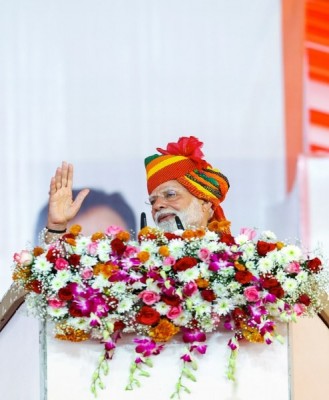
India aims to achieve 100 GW solar power generation by 2022: Swain
Bhubaneswar/UNI: India is on course to achieve the ambitious generation target of 100 GW of solar power by 2022, Managing Director of the Solar Power Corporation of India (SPCI), Jatindranath Swain said here today.
Addressing a national symposium of ‘Energy Challenges and Promises’ held at the SOA Deemed to be University here. Mr.Swain said the solar energy sector had travelled a long way with the total installed capacity now being 32 GW with another 18 GW under installation and 24 GW in various stages of tendering.
“With three more years to go, 100 GW of solar energy generation appears a distinct possibility”,he said adding that solar tariff had come down to Rs. 2.44 per unit of electricity and has become ,” cheaper than the cheapest source of energy—thermal power.
The symposium was organised by the newly established Indian Energy Congress (IEC) in collaboration with SOA Deemed to be University and National Institute of Science and Technology (Autonomous), Berhampur.
President of IEC Pravakar Swain presided over the program which was also addressed by Mr. Bishnupada Sethi, Principal Secretary in the energy department and Managing Director of the Odisha Hydro Power Corporation (OHPC), Prof.C.R.Tripathy.
Mr. Swain said though photovoltaic cells were invented in 1839, its first commercial application was made in 1958. But the dramatic surge in price of crude oil since the 1970s’ caused scientists to think about harnessing solar energy.
The SECI,he said was created to help boost solar capacity through the PPP mode and the massive drop in solar tariff had expanded its acceptability among the electricity distribution companies.
Mr. Swain said India was best placed geographically to harness the vast potential of solar energy generation which was estimated at 749 GW assuming only three per cent of its wasteland was utilized for solar production at current levels of technology and cell efficiency.
“The solar potential is best in Ladakh, though it has issues concerning evacuation of the generated power, Rajasthan followed by western Madhya Pradesh, Gujarat, the Deccan Peninsula, Gangetic plains and the North East in that order,” he said.
But it was because of difficulties in aggregating large chunks of land, most of solar installations were now coming up in Rajasthan, Gujarat, MP, Karnataka and Andhra Pradesh where large plots of barren land were available, Mr. Swain said.
He further said states like UP, Jharkhand, Bihar, Odisha and Chhattisgarh needed to do more to attract more investment in solar power in their respective states.
Principal Secretary Energy Bishnupad Sethy said the Odisha government had identified the challenges in the power sector which was crucial to the state’s economy and was venturing into solar and other avenues for generation of electricity.
The targets before the government included 100 per cent coverage of households with power supply, availability of 24x7 reliable power and reduction of carbon emission caused by power generation in thermal units, he said.
“All thermal plants would be shut down in 20 to 30 years time as Odisha was striving to become carbon netural,” Mr. Sethi said.
Support Our Journalism
We cannot do without you.. your contribution supports unbiased journalism
IBNS is not driven by any ism- not wokeism, not racism, not skewed secularism, not hyper right-wing or left liberal ideals, nor by any hardline religious beliefs or hyper nationalism. We want to serve you good old objective news, as they are. We do not judge or preach. We let people decide for themselves. We only try to present factual and well-sourced news.







